Rolex Sydney Hobart Yacht Race - National Pride, International Icon
Sydney/Hobart, Australia
“It would not be the same growing up in Australia not watching the Boxing Day Test [cricket match] followed by the start of the [Rolex] Sydney Hobart, one of the great sailing challenges”, says Phil Waugh, the Australian rugby union star and crewmember of the first boat to finish the 2011 Rolex Sydney Hobart.
Such is the significance of the Rolex Sydney Hobart in the Australian national psyche that the 2011 Young Australian of the Year Jessica Watson, the youngest person to sail alone around the world, took on the race in 2011 as “her next big challenge”.
Robert Oatley, the owner of Wild Oats XI the race record holder, six times first to finish, and twice overall winner keeps returning because: “it is one of the hardest yacht races in the world to win, and I am very proud to win it.”
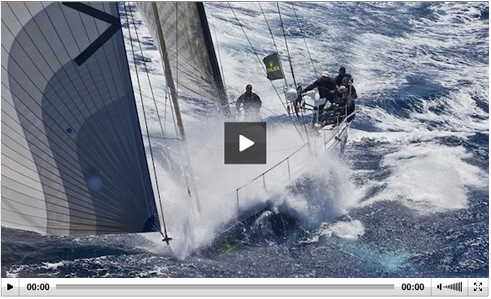
Media Matters
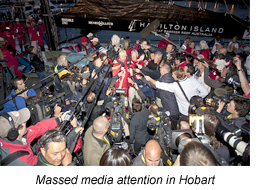 The start in Sydney and first arrivals in Hobart receive blanket coverage from every major print and television news outlet in Australia. The start is broadcast live to a television audience measured in hundreds of thousands and, should they be considered an assessment of media impact, 14 helicopters hovered over the fleet on 26 December 2012. The race finish elicits similarly intense attention; Australian Traveller includes witnessing it as one of the Top 100 things to do in Australia. It is listed ahead of a seat at the Australian Open tennis tournament and just behind going to the Melbourne Cup horse race. The start in Sydney and first arrivals in Hobart receive blanket coverage from every major print and television news outlet in Australia. The start is broadcast live to a television audience measured in hundreds of thousands and, should they be considered an assessment of media impact, 14 helicopters hovered over the fleet on 26 December 2012. The race finish elicits similarly intense attention; Australian Traveller includes witnessing it as one of the Top 100 things to do in Australia. It is listed ahead of a seat at the Australian Open tennis tournament and just behind going to the Melbourne Cup horse race.
The Rolex Sydney Hobart justifies a page of its own on the Tourism Australia website confirming the country’s recognition of its importance to ‘brand Australia’ abroad; that it is emblematic of the nation. The site describes the race as “an Australian summertime tradition” and an “iconic Australian summer experience”. This local fervour for the race has caught on around the world. It is not just in its own backyard that it is deemed a moment worthy of mainstream news attention. From The New York Times in the US, the BBC and The Daily Telegraph in the UK, La Stampa in Italy, Neue Zürcher Zeitung in Switzerland, Der Spiegel in Germany to El Mundo in Spain, news about the event competes successfully for broadcast and column space globally.
Traditional Values
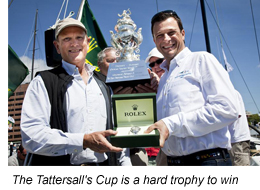 From where does this intense scrutiny and passionate interest originate? The event boasts a rich history despite the first edition in 1945 being a humble affair. Only nine yachts took part, yet the fledging event immediately seems to have caught the imagination of those outside the sport. The most significant trophy awarded at the Rolex Sydney Hobart is the George Adams Tattersall Cup: 65cm of hand-wrought sterling silver. It was presented to organizers, the Cruising Yacht Club of Australia, in 1946 by the estate George Adams, a Hobart businessman, philanthropist and founder of the Tattersall’s Lottery, at the instigation of his great-nephew William, who clearly felt the race worthy of a grand piece of silverware. The Tattersall’s Cup goes to the overall victor and is one of the most coveted trophies in yacht-racing. Last year’s winner Stephen Ainsworth tried for 14 years to capture the prize: “It is a huge thrill to win this race. I know how hard it is to win. I have been trying for a long time.” From where does this intense scrutiny and passionate interest originate? The event boasts a rich history despite the first edition in 1945 being a humble affair. Only nine yachts took part, yet the fledging event immediately seems to have caught the imagination of those outside the sport. The most significant trophy awarded at the Rolex Sydney Hobart is the George Adams Tattersall Cup: 65cm of hand-wrought sterling silver. It was presented to organizers, the Cruising Yacht Club of Australia, in 1946 by the estate George Adams, a Hobart businessman, philanthropist and founder of the Tattersall’s Lottery, at the instigation of his great-nephew William, who clearly felt the race worthy of a grand piece of silverware. The Tattersall’s Cup goes to the overall victor and is one of the most coveted trophies in yacht-racing. Last year’s winner Stephen Ainsworth tried for 14 years to capture the prize: “It is a huge thrill to win this race. I know how hard it is to win. I have been trying for a long time.”
Throughout its existence, the Rolex Sydney Hobart has attracted the participation of international yachtsmen and women, some of who are more famous for their prowess outside the sport. Communication mogul, Ted Turner, IT supremos Larry Ellison, Niklas Zennstrom and Hasso Plattner, and, British statesman Sir Edward Heath have all competed at various points, drawn to the challenge. Sir Robin Knox-Johnston, the first person to sail single-handed and non-stop around the world competed for the first time in 2010, offering a simple reason: “The Rolex Sydney Hobart Race is seen as one of the world’s great classic yacht races.”
Human Nature
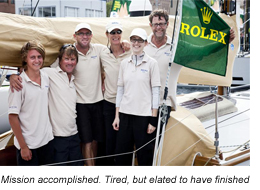 The race’s status as a classic is drawn from many elements. For the average crew the chances of winning are extremely low. The attraction lies in the many unknowns of racing 628 nautical miles, the exhilaration and the sense of accomplishment at the finish. It has earned a fearsome reputation, justified by the route touching some of the toughest open waters on the planet; stories of derring-do, storms and even tragedy echo in its wake. Briton Mike Broughton, a regular competitor and highly experienced navigator, whose first experience of offshore racing was the infamous1979 Fastnet Race, has observed many finishers over the years: “There’s a look in people’s eyes when they get to Hobart; quite often it is bloodshot and tired, but there is an elation at having done the race. It means a great deal, a huge amount.” The race’s status as a classic is drawn from many elements. For the average crew the chances of winning are extremely low. The attraction lies in the many unknowns of racing 628 nautical miles, the exhilaration and the sense of accomplishment at the finish. It has earned a fearsome reputation, justified by the route touching some of the toughest open waters on the planet; stories of derring-do, storms and even tragedy echo in its wake. Briton Mike Broughton, a regular competitor and highly experienced navigator, whose first experience of offshore racing was the infamous1979 Fastnet Race, has observed many finishers over the years: “There’s a look in people’s eyes when they get to Hobart; quite often it is bloodshot and tired, but there is an elation at having done the race. It means a great deal, a huge amount.”
Competitors are drawn to the raw nature of testing themselves against the elements. The mix of hard physical challenges is well documented, and for some sailors there is fear to overcome; something Broughton is adept at explaining: “We start in Sydney where it is lovely and sunny, 26 degrees, and we’re going on yacht race. But, you turn right (south) out of the Heads and often on the first night you are straight into a southerly bringing much colder winds from Antarctica and the sea state can be pretty brutal. Fear is not something you want to talk about. It is kept in the back of your mind, but it is one of the challenges of this race.” The Rolex Sydney Hobart confronts human spirit and endeavour, and that pulls people towards it, participants and public alike.
Non-sailors may find it difficult to understand the intricacies of yacht racing and the handicap system that means the first to finish is not necessarily the winner. What they do comprehend is enterprise, courage and adventure. The element of personal challenge that inhabits this race plays a full part in attracting the wider appreciation.
Respected Australian sport journalist, Amanda Lulham, is captivated by the legend, and over many years has made it her mission to impart the character of the race and its competitors to her newspaper readership: “It has a wonderful tradition; it is a tradition about stories, about people, about boats, about technology. There is so much humanity and heart ache in the race, great stories of survival, stories of ordinary people doing extraordinary things that capture the imagination.”
Live Theatre
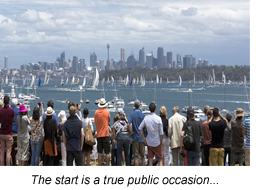 The start each year on Sydney Harbour is something that has infiltrated the public consciousness. It is a rendezvous moment in one of the world’s great cities. The time of year, the ever-growing folklore, the spectacle: all have an impact and the result is dramatic. According to Lulham, “There are only three things you do on Boxing Day in Australia. One is to watch the start of Rolex Sydney Hobart on Sydney Harbour, the second is to fire up the barbeque, and the third is to watch the cricket.” Hundreds of thousands of people pack the foreshore and Harbour is congested with big boats, little boats, kayaks, dinghies. Everyone in Sydney who can get on the water does so, the rest watch from shore or join the international television audience. No other sailing event in the world commands such avid attention, bringing a nation to near standstill for an hour. The start each year on Sydney Harbour is something that has infiltrated the public consciousness. It is a rendezvous moment in one of the world’s great cities. The time of year, the ever-growing folklore, the spectacle: all have an impact and the result is dramatic. According to Lulham, “There are only three things you do on Boxing Day in Australia. One is to watch the start of Rolex Sydney Hobart on Sydney Harbour, the second is to fire up the barbeque, and the third is to watch the cricket.” Hundreds of thousands of people pack the foreshore and Harbour is congested with big boats, little boats, kayaks, dinghies. Everyone in Sydney who can get on the water does so, the rest watch from shore or join the international television audience. No other sailing event in the world commands such avid attention, bringing a nation to near standstill for an hour.
The finish is no less extraordinary. Hobart is a summer destination, and is in festive mood between Christmas and New Year. Hobart resident Bruce Montgomery is another respected member of the Australian media. He has covered the race since 1968 and for him: “the Rolex Sydney Hobart is strategically very important to Tasmania from a tourism point of view; it is what places Hobart and Tasmania on the world map. Most people are aware of the race for good and bad reasons, but above all they know this is one of the great, blue riband ocean races.”
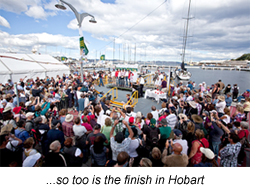 It is a remarkable fact that start and finish are both regarded as something to witness; something you would tell your friends ‘I was there’. Few sailing events in the world can truly claim to cross the boundary between niche sport and major attraction. Montgomery says the proof of this event’s grand prix draw is plain to see: “The start is always a spectacle, and, here in Hobart whatever the time of day or night the docks can be absolutely crowded. People come out in the thousands. On the docks, out in boats, Hobart is at its best.” In 2011 when the first two yachts to finish were separated by three minutes, 10,000 were estimated to be on the dock captivated by the moment. It is a remarkable fact that start and finish are both regarded as something to witness; something you would tell your friends ‘I was there’. Few sailing events in the world can truly claim to cross the boundary between niche sport and major attraction. Montgomery says the proof of this event’s grand prix draw is plain to see: “The start is always a spectacle, and, here in Hobart whatever the time of day or night the docks can be absolutely crowded. People come out in the thousands. On the docks, out in boats, Hobart is at its best.” In 2011 when the first two yachts to finish were separated by three minutes, 10,000 were estimated to be on the dock captivated by the moment.
Legend in the Making
There is no single factor that has formed the legend. Starting and finishing in major cities, the timing, the human endeavour, the romance and the show: all are equally important. With Wild Oats XI capturing an historic, second treble of first to finish, overall winner and the race record at the 68th edition, the Rolex Sydney Hobart Yacht Race shows no sign of letting go of its grip on the imagination, or the status as an iconic sporting event.
How to Follow the Event
Further information on the Rolex Sydney Hobart may be found at www.rolexsydneyhobart.com
To receive daily reports and to download high-resolution images, copyright free for editorial purposes, register online at www.regattanews.com
TOP
|